Taking a look at the First Quarter graphs
Posted by Heading Out on April 6, 2006 - 1:22am
The EIA in their summary comments have noted that the month will see a lot of refinery maintenance, and that this will reduce the stocks in gasoline, since demand will continue, while supply is reduced. This, they suggest, may provide some additional pressure on prices over the month, despite a relatively even demand.

In so far as it is likely to, it appears that production has restabilized after the summer. However we have lost about 500,000 bd.
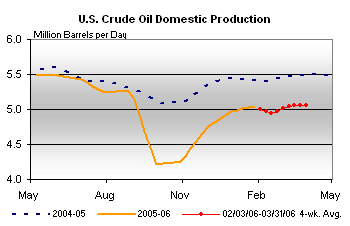
The make-up has not been supplied by imports.
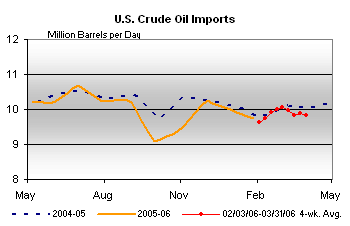
This has been running about the same as last year, but the input to the refineries has been reduced due to hurricane damage, allowing some buildup in the crude stocks.
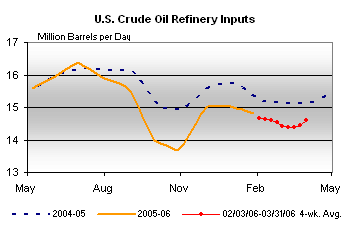
.
Turning to gasoline, the gas stock picture is perhaps the most interesting, since it shows a significant increase over normal volumes, though bear in mind that other countries which store as refined product rather than crude, may have been selling this to us since driving is down, relatively, in the winter.
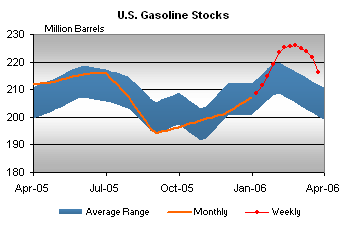
Thus one sees, in imports, slightly higher consistent levels over the past months.
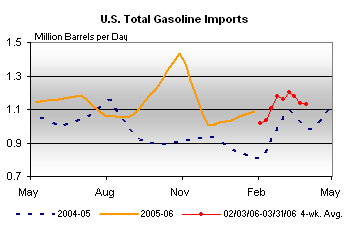
This is in contrast to production of gasoline
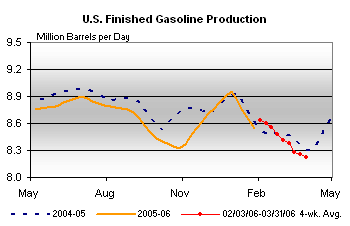
which is slightly lower than normal, due to the problems with refineries discussed above. Domestic demand, however, remains somewhat higher than last year, perhaps due to the mildness of the weather.
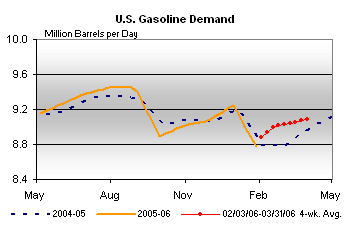
.
The other significant production from refineries is, of course, the distillate, for heating oil and diesel, and the picture here shows that domestic stocks are also above normal, although not varying quite as dramatically as did the gasoline.
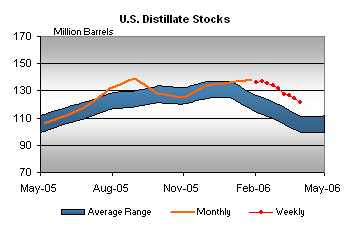
Domestic production while holding up while there was the potential for demand should the winter have been harsher, is not dropping off as that need diminishes.

The anticipated demand was also evident in the imported levels of distillate leading into the winter, but with that passing, the imports have fallen back to last year's level.
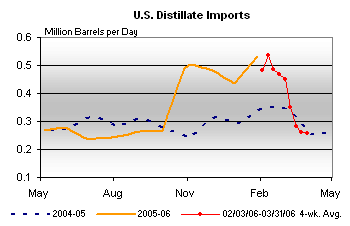
And, perhaps because of a little overstocking at times, demand is also now falling below last year's level.
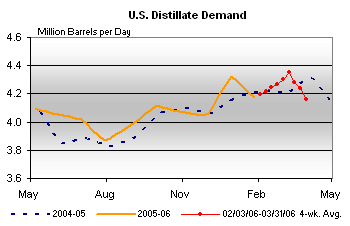
Incidentally there has been quite a bit of discussion of these curves, and perhaps other explanations in the comments from the last two or three posts, so it might be useful, with the curves in front of you, to glance at some of those again.




Thxs for posting this info. The major conclusion I draw from these graphs is that I see no solid proof that America has powered down in fuel consumption in any meaningful way yet, even though gas prices are much higher than pre-Katrina levels.
Bob Shaw in Phx,AZ Are Humans Smarter than Yeast?
I suspect it is mostly heavy sour but without hard data its just a guess.
Key bit of missing Data..
RR
I don't really see a heavy sour build as an issue, though. If refineries are building inventories of heavy sour crude, that means they must be configured to process it. You don't build heavy sour if you aren't. The yields from heavy sour crudes are not substantially different than from light sweet crudes as long as the refinery is configured for a heavy sour slate.
RR
The overall picture is a shift in the US from crude imports to refined products imports. Demand is not retracting (at least at a significant pace).
The economic strength of the US seems to be still offsetting the moderately high prices. Difficulties in importing crude or refining it are met simply by importing the final product.
This data also tells you something about the threats made by foreign exporters of cutting crude supply to the US: it'll have a much smaller impact than intended. As long as the strong position of the dollar holds the US will get all the oil needed from the world markets, as crude or finished product.
Have you looked at the gold market lately? There is your prognosis for the US dollar.
Oh, I'm sorry, you didn't want to do that? Oh, OK. Maybe next time.
I've that same feeling but I'm no economist, I left it open to everyone's sense.
What's happening to those barrels? Where did they go?
Ron Patterson
Where did all those barrels go, especially in light of the fact that inventories in all three are well above those of the same period last year?
If we are still using the same amount of gasoline and other products as last year, that is a real poser.
Ron Patterson
Pensacola, Fl.
Thank you once again for the sigificant amount of work you've done in putting this information into a comprehensible form. I have a few comments and thoughts I would like to share with all of you, and please tell me whether I have any foundation in them or if I am completely wrong.
If I were running a large refinery, I think it would be rather convenient to go ahead and perform any and all deferred maintenance at this point (that I have been putting off for the past year) for a couple of reasons:
1. I get the impression that the refineries have been running all out to keep up with demand, hence maintenance is going to be a big issue in keeping these complexes online.
2. It would be better to hold onto all that crude and refine it at a later time, as the end products, such as gasoline and distillates, will bring me a significantly higher price if I just wait a few months before I begin production again in earnest.
Now, I am by no means a conspiracy theorist, but I think Exxon-Mobil and Chevron-Texaco (that is 4 major oil companies that merged to become 2 really big ones) would not hesitate to exploit such a scenario, I have to think that they would not mind the profits from such a course. However, this whole sweet vs sour crude thing is far beyond my area of expertise (paramedic and Emergency Room RN. Is it possible that the majors have been stocking up on heavy crude only to have no other options available (ie heavy sour crude is better than not having any crude oil at all)? A question I would like to pose is it possible that during the routine maintenance now going at these refineries, is it possible to convert the production process to accomadate all of the heavy/sour crude now on the market, or would this entail such a re-engineering of the basic process that I would have to build entirely new refinery? Seeing as currently no one is building any new refineries in the US at present, the latter would seem not to be occuring in the near future.
How much more difficult is 'cracking' heavy sour vs sweet light crude? (Man, I love that term. It's so Macho!)
As always, I would appreciate the TOD community's input on this.
Subkommander Dred
The primary reason for doing it now is because the weather is better than normal, and typically we have been able to build up some stocks through the winter.
Is it possible that the majors have been stocking up on heavy crude only to have no other options available (ie heavy sour crude is better than not having any crude oil at all)?
If a refinery is configured for it, they are probably stocking up on heavy because the price differentials are very large. At current prices heavy sour crude makes a lot more money than light sweet.
A question I would like to pose is it possible that during the routine maintenance now going at these refineries, is it possible to convert the production process to accomadate all of the heavy/sour crude now on the market, or would this entail such a re-engineering of the basic process that I would have to build entirely new refinery?
You wouldn't have to build a new refinery, but it isn't something you could slap in during a spring turnaround. It requires significant modifications, and hundreds of millions in capital (coker and hydrotreater for sure).
RR
As a doomer, I guess I'm predisposed for this to conjure in my mind the old Hee Haw song, "Gloom, despair and agony on me... if it weren't for bad crude I'd have no crude at all..."
Consumers must work with oil powers to tackle crisis
They also think we're stocking the wrong kind of reserves:
Domestic production of just about everything is down leading to crude builds.
We are currently making up for lack of refining by importing more refined products.
So is there a chart or statistics of what non U.S. gasoline and distillate stocks are doing? Are they being maintained or are/were they being drawn down by U.S. purchases which can't be maintained long term?
If the crude is sweet enough you don't have to crack it at all. All you need is a fractionating column, which runs at relatively low temps and pressures. Crackers, hydrocrackers, cokers, and hydrotreaters run at high temps and pressures and tend to blow up on unscheduled shutdowns and startups.
But now that you mention it we always seem to divide oil into two catagories, the "light-sweet" verses the "heavy sour" stuff. Is there no "light-sour" or "heavy-sweet" oil?
Am I missing something here?
Ron Patterson
Pensacola, Fl.
There are light sour crudes. I am not familiar with any heavy-sweet crudes, but I would guess that there are some. But most refineries configured for a heavy crude operation are also configured for a sour crude operation, hence the heavy sours are what you are looking for (because they are much cheaper).
Hope that helped.
RR
I'm pretty sure I got that right. If not, someone here will correct me.
It would be interesting to remove the infuence of the mild winter and reduced home heating oil use from the graph. This would serve to make the remaining use (presumably mostly from transportation) look larger. In other words, some of what might look like reduced use is just the mild winter.
I don't really know ANYONE who has reduced their VMT in response to the fuel costs. Period. They do complain more though, but it's not a big topic usually.